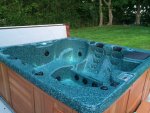I just started up my spa and the last thing I need to get in range is the calcium hardness. I am using the LaMotte Color Q and Taylor Calcium Hardness tests. Per the pool math calculator I am supposed to add 16 oz to my 450 gallon spa to get to a 300 ppm hardness. After adding that my LaMotte test is showing 200 and the Taylor test keeps proving a fading end-point and I cannot get an accurate reading with it. I even tried Taylor's suggestion of adding 5-6 drops of the r-0012 first if metal interference is occurring but that did not help the fading end-point. How can I get an accurate test reading if metals are present? I have test strips for iron and copper and it looks like I have .03-.06 cooper in the spa, but the strip is hard to read. I added Leisure Time's Metal Gon at start-up (not sure if this has anything to do with it).
Any help on how I can accurately test the calcium hardness given my current situation, and any advice on how to remove the metals if they are in fact present in the spa would be greatly appreciated.
Any help on how I can accurately test the calcium hardness given my current situation, and any advice on how to remove the metals if they are in fact present in the spa would be greatly appreciated.


